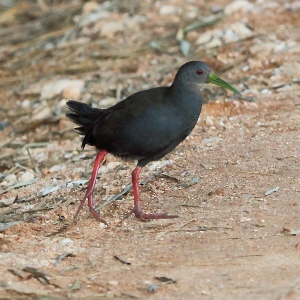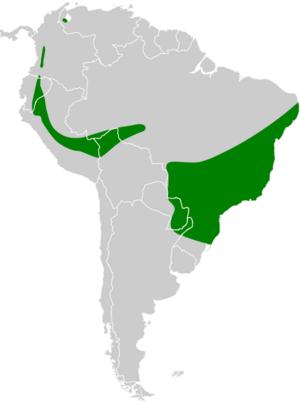Blackish rail facts for kids
Quick facts for kids Blackish rail |
|
|---|---|
 |
|
| Blackish rail at Jacutinga, Minas Gerais State, Brazil | |
| Conservation status | |
| Scientific classification | |
| Genus: |
Pardirallus
|
| Species: |
nigricans
|
 |
|
| Synonyms | |
|
|
The blackish rail (scientific name: Pardirallus nigricans) is a type of bird from the rail and crake family. These birds are found in several South American countries. You can spot them in places like Argentina, Brazil, Colombia, Ecuador, Paraguay, Peru, and Venezuela. They might also live in Bolivia.
Contents
About the Blackish Rail
The blackish rail is part of a larger group of birds called Rallidae. This family includes rails, crakes, and coots. Scientists sometimes group the blackish rail with other similar birds. For example, it was once placed in the Rallus genus. It is also closely related to the plumbeous rail. Some experts even think they might be the same species.
There are two main types, or subspecies, of the blackish rail. One is called P. n. nigricans. The other is P. n. caucae.
What Does a Blackish Rail Look Like?
Blackish rails are medium-sized birds. They are usually about 27 to 29 centimeters (11 to 11.5 inches) long. An adult male can weigh around 217 grams (7.7 ounces). Both male and female blackish rails look very similar.
These birds have a long bill that is yellow-green in color. Their legs are a pretty pinkish shade. The most common type, P. n. nigricans, has dark brown feathers on its back. Its chin and throat are white. The rest of its face and belly are dark gray. The P. n. caucae subspecies is a bit bigger. It also has a larger, whiter patch on its throat. Its belly feathers are lighter, especially near its tail.
Where Do Blackish Rails Live?
Blackish rails live in different areas that are not connected. This is called a "disjunct distribution." The P. n. nigricans subspecies lives in two main regions. One group is in northeastern Brazil. From there, they spread south and west into southeastern Brazil, northern Argentina, and eastern Paraguay. The other group forms a curved shape. This goes from western Brazil through central Peru and Ecuador. It almost reaches the border with Colombia. There have also been a few sightings in Bolivia. This suggests they might live there too.
The P. n. caucae subspecies lives in central Colombia. It is named after the Cauca River in that region. Blackish rails have also been seen in western Venezuela. However, it's not clear if these are P. n. caucae or a new type.
These birds love wet places. They live in marshes, along waterways with lots of plants, and in rice fields. You can also find them in wet grasslands and lightly wooded swamps. They mostly live in low-lying areas. But in the Andes mountains, they can be found between 800 and 2,200 meters (2,600 to 7,200 feet) high. One bird was even seen in Peru at about 4,100 meters (13,500 feet)!
How Do Blackish Rails Behave?
Moving Around
Blackish rails do not seem to travel much. Most of them stay in one place. Only one bird has been recorded as a "vagrant." This means it wandered far from its usual home in Peru.
What They Eat
These birds usually look for food hidden among plants. Sometimes, they come out into open areas. They might search at the edge of plants or in small clear spots. We don't know exactly what they eat. But scientists think they mainly eat insects and other small creatures without backbones. There's even one story of a rail going into a restaurant garden for food scraps!
How They Raise Their Young
We don't know exactly when blackish rails have their babies. One nest was found in a swamp. It was a cup-shaped nest built among plants on a tree stump. This nest might have belonged to a blackish rail or a plumbeous rail.
Female rails usually lay two or three eggs. In captivity, the eggs hatch in about 18 to 21 days. The baby chicks are born covered in black downy feathers. They leave the nest very soon after hatching. Both parents help take care of the young chicks.
Their Calls
Blackish rails make many different sounds. What is believed to be the male's song is a very sharp, loud call. It sounds like a repeated "whuueeee" or "wheee." Other sounds they make include a fast, metallic "tii'd'dit." They also make a "complaining 'keeeeaaa'" sound. Another call is a quick, repeated "chchchee." They can even make a sharp double squeak.
How Many Blackish Rails Are There?
The IUCN (International Union for Conservation of Nature) says the blackish rail is a species of "Least Concern." This means they are not currently at risk of disappearing. They live across a very large area. Scientists estimate there are up to 67,000 adult birds. We don't know if their numbers are going up or down.
No immediate dangers have been found for these birds. They are considered common in some places. But generally, they are found in scattered groups and are not very common. It's hard to count them because they are very secretive. This makes them difficult to see and study.


